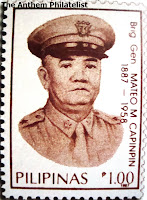The National Anthem of Iceland
 Much like the United States anthem, the Icelandic national anthem is originally written for a particular occasion and it probably did not occur to either the poet or the composer that the song was destined to become a national anthem.
Much like the United States anthem, the Icelandic national anthem is originally written for a particular occasion and it probably did not occur to either the poet or the composer that the song was destined to become a national anthem.In Iceland, nation-wide celebrations were held throughout 1874 to mark the 1000th anniversary of the first Norse settlement of the island. (This is the "Iceland's thousand years" that are referenced in the anthem.) To mark the occasion, the Bishop of Iceland decreed that church services on August 2 of that year were to be held based on the anniversary, and the text to be presented was Psalm 90. The Rev. Matthías Jochumsson then decided to write a poem based on the Biblical text and the millennial anniversary. While abroad in Edinburgh, Scotland, he met up with Sveinbjörn Sveinbjörnsson, who Jochumsson asked to compose music for his poem.
While popular, it was not considered a national anthem. Icelandic independence was still over 40 years away. At the time that "Ó, Guð vors lands" (O, God of Our Land) (also known as "Lofsöngur" (Song of Praise)) was written, Icelanders usually sung "Eldgamla Ísafold" by Bjarni Thorarensen. However, that song had anti-Danish (the colonial power) lyrics and was set to the tune of the British national anthem. Therefore "Ó, Guð vors lands" (O, God of Our Land) was played as the national anthem when soverignity was proclaimed.
Sveinbjörn Sveinbjörnsson (28 June 1847 – 23 February 1927), was an Icelandic com
 poser best known for composing Lofsöngur, the National Anthem of Iceland. Sveinbjörn was born in Seltjarnarnes. He was studying divinity when he met a young Norwegian violinist and composer, Johan Svendsen. At the time, Svendsen had just finished his studies in Leipzig and encouraged Sveinbjörn to go and study music, either in Leipzig or Copenhagen. Sveinbjörn went to Copenhagen, but later carried on to Leipzig where his teacher was Carl Reinecke. Consequently, Sveinbjörn gained a far higher level of musical education than other musicians in Iceland at that time.
poser best known for composing Lofsöngur, the National Anthem of Iceland. Sveinbjörn was born in Seltjarnarnes. He was studying divinity when he met a young Norwegian violinist and composer, Johan Svendsen. At the time, Svendsen had just finished his studies in Leipzig and encouraged Sveinbjörn to go and study music, either in Leipzig or Copenhagen. Sveinbjörn went to Copenhagen, but later carried on to Leipzig where his teacher was Carl Reinecke. Consequently, Sveinbjörn gained a far higher level of musical education than other musicians in Iceland at that time.As the musical opportunities were limited in Iceland at the end of the 19th century, Sveinbjörn moved to Edinburgh. His composition pieces were mostly melody songs or poetical chamber music in the spirit of Mendelssohn. Sveinbjörn also composed a considerable number of folk songs. In 1922 the Icelandic parliament, Althing, decided to grant him a pension, which allowed him to return to Iceland. He died in Copenhagen.
Matthías Jochumsson (11 November, 1835 – 18 December, 1920) was an Icelandic poet, playwright, and translator. He is best known for his lyrical poetry and for writing the national anthem of Iceland, Lofsöngur, in 1874. He was born in Skógar into a poor family and traveled to the continent to further his education. Intending to become a business man, Jochumsson discovered his passion for languages and literature. He died in Akureyri, where his house, Sigurhæðir, is now a museum, devoted to his life and work.
The stamp above features Matthias Jochumsson, the lyricist of Iceland's National anthem. Below is Sveinbjörn Sveinbjörnsson. the composer.






